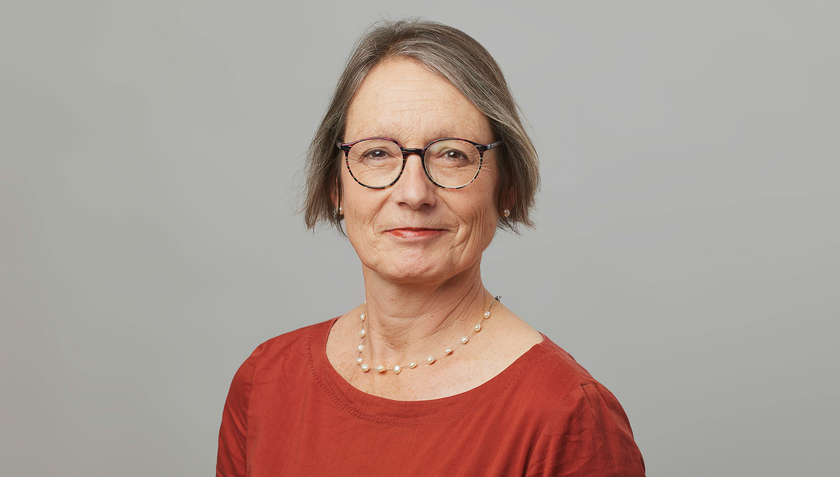Specialist in the detection of harmful substances

Juliane Hollender’s group uses high-resolution mass spectrometry to search for unknown micropollutants in groundwater and investigates what effect they have and how they can be removed. After all, groundwater is our most important drinking water resource. The environmental chemist appreciates it when her research findings are directly applied in practice.
“I still drink water from the tap,” says Juliane Hollender. This is despite the fact that the results of the analyses she carried out at Eawag with her research group startled the general public in 2019. “Poison in drinking water” was the headline in the Swiss press at the time. And the scientific publications on the water analyses from Dübendorf attracted so much attention from experts around the world that Hollender was one of the most cited scientists in the world between 2019 and 2021.
What had happened? The environmental chemist recalls: “In a pilot study, we sampled groundwater containing various degradation products of the pesticide chlorothalonil, which is used in large quantities and which the European Food Safety Authority had previously categorised as potentially carcinogenic. As groundwater is the most important resource for our drinking water, we caused quite a stir with this finding.” Hollender is head of the Eawag research group “Environmental Behaviour of Pollutants” and titular professor at ETH Zurich. The discovery of the degradation products, which had never before been detected in groundwater, was achieved with the help of high-resolution mass spectroscopy. This makes it possible to search for expected degradation products and even unknown substances – processes technically referred to as “suspect screening” or “non-target screening” respectively.
Scientist with a doctorate in engineering
Hollender is an internationally recognised expert in this field; she established it together with her colleagues at Eawag when she came to Switzerland from Germany 20 years ago. She grew up near Cologne. “I had great chemistry lessons at school,” she says. “I was also interested in what makes up everything.” She therefore decided to become a chemist. She studied at the Universities of Bonn and Freiburg im Breisgau, where she specialised in biochemistry and completed her doctorate in 1994 at the Technical University of Berlin in the field of technical environmental protection. “Although I have a doctorate in engineering, I’m much more of a scientist,” she says. She therefore soon chose the field of organic pollutants and their degradation products as her area of research, which is why she joined Eawag in 2005. “I was very interested in Eawag because the institute was very well known – for water research generally and for my subject area in particular,“ she says.
Hollender has been working with the experts at the Federal Office for the Environment (FOEN) for years, and it, together with the cantons, initiated the search for degradation products of pesticides in groundwater. The environmental chemist was initially sceptical: “I didn’t expect that we would find anything interesting, as so much research had already been done in this area,” she says. “But in the end, we really did track down something new.” Further investigations, including by the cantons, have shown that chlorothalonil degradation products are widely polluting groundwater in the Swiss Central Plateau. At more than 60 percent of the measuring points, a certain metabolite exceeds the threshold value for pesticides classified as relevant for drinking water. This threshold is 0.1 micrograms per litre.
“Fortunately, the use of chlorothalonil is no longer allowed,” says Hollender. However, the problem will probably be with us for a long time to come, as it often takes years for pollutants to degrade or be washed out. “Groundwater has a long memory,” notes the scientist. “In the past, scientists usually only searched for the original substances, but these often do not end up in the groundwater; instead, it’s the degradation products that are more water-soluble and mobile and can therefore be more relevant for the groundwater.”
Testing countermeasures
Nevertheless, Hollender is convinced that the quality of the groundwater in Switzerland is so good that it can be safely consumed as drinking water. This is because water suppliers endeavour to ensure clean production and the threshold values are defined at conservative, precautionary levels. Nevertheless, the water catchments must be well monitored, and measures need to be taken if pollution levels are too high. This is why, following the discovery of chlorothalonil degradation products in groundwater, it was important for her to work with other Eawag researchers to investigate how these substances can be removed from drinking water. Their conclusion: ozone has no effect, but activated carbon does. “However, it needs relatively fresh activated carbon,” says the scientist.
Hollender particularly appreciates this applied research, “where you can see that our results have a direct impact on practice.” One of her career highlights at Eawag was working in a group of scientists and engineers who improved the treatment of wastewater. It only took 15 years from research to large-scale technical implementation. For this achievement, the researchers were awarded the Sandmeyer Prize of the Swiss Chemical Society in 2024.
Children’s paintings in the office
The award certificate hangs on the wall in Hollender’s office alongside other mementos. Taking particular pride of place: a large, colourful painting. “My son painted this when he was a boy,” says Hollender. “I interpret it as some kind of world, an alien planet perhaps.” In the meantime, her son and daughter have grown up. Sometimes the mother wonders how she coped with the double commitments of family and career back then. “It was sometimes difficult, but somehow I always managed,” she says. Today, she has a little more free time. “But I do work quite a lot,” admits Hollender. For instance, she is also involved in the massive EU project “Partnership for the Risk Assessment of Chemicals”. “If you want to make a difference, it’s important to be part of these collaborations,” she says. In addition to the chlorothalonil degradation products, Hollender and her team detected other poorly degradable and mobile pollutants in the groundwater. These include trifluoroacetic acid (TFA), which comes from pesticides, refrigerants and propellants, among other things. According to a FOEN pilot study, trifluoroacetic acid is present in groundwater throughout the country, with particularly high concentrations under arable land. Hexafluorophosphate (PF6-) is one of the industrial chemicals recently discovered in groundwater.
The environmental chemist expects to find even more pollutants like these in groundwater in the future. “However, I don’t think there are many substances that we will find in such high concentrations and across such a wide area as the chlorothalonil degradation products,” says Hollender. “After all, tonnes of this pesticide were applied to the fields.” Pollutants released from a wastewater treatment plant are likely to enter the groundwater in much smaller quantities.
Predicting toxicity
“What drives me in my research is not just the detection of unknown substances,” says the scientist: “I also want to determine the effects they have.” Her group is therefore conducting research in the field of bioaccumulation, i.e. how organisms absorb organic pollutants, and is working together with the Environmental Toxicology department. In addition, her group is now using mass spectrometry to predict the toxicity of unknown substances in environmental samples. “Mass spectra tell us something about the structure of a substance, and the structure is of course important for its effect,” says Hollender, explaining the background to this work, which involves databases with huge amounts of data and machine learning methods.
“I’m not a specialist in artificial intelligence, but you have to get to grips with it and work with others who are familiar with it,” remarks Hollender. Digitalisation has also changed her field of research, because ever larger amounts of data are handled in science. However, the environmental chemist is convinced that people will not be rendered obsolete in research: “It requires our expertise. You can’t do everything at the touch of a button.”
Created by Barbara Vonarburg for the Info Day Magazine 2025



